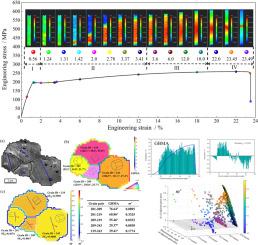A new perspective on tensile yield plateau formation in extruded Mg-4.83Gd-2.36Nd-0.21Zr alloy
IF 13.8
1区 材料科学
Q1 METALLURGY & METALLURGICAL ENGINEERING
引用次数: 0
Abstract
The occurrence of the tensile yield plateau in Mg alloys is relatively rare and its underlying reasons have been controversial. In this study, we systematically investigated the deformation mechanism of an extruded Mg-4.83Gd-2.36Nd-0.21Zr alloy, which exhibited an obvious tensile yield plateau. Quasi-in-situ EBSD analysis revealed that basal slip was the predominant mechanism in the tensile yield stage, which was attributed to the weak rare earth texture that facilitated basal slip activation and the fine recrystallized grains that suppressed twinning. The yield drop resulted from the combined effects of the easy activation of basal slip and the dislocation pinning by solute atoms. Additionally, the random distribution of grain orientations, high grain boundary misorientation angles (GBMA), and small grain sizes hindered intergranular deformation transfer between neighboring grains. The weak deformation transfer contributed to the formation of yield point elongation. This work underscores the role of texture, grain orientations, and GBMA in determining the yield plateau, offering a new perspective on yield plateau formation in Mg alloys.

挤压Mg-4.83Gd-2.36Nd-0.21Zr合金拉伸屈服平台形成的新视角
镁合金中出现拉伸屈服平台现象比较少见,其原因一直存在争议。在本研究中,我们系统地研究了Mg-4.83Gd-2.36Nd-0.21Zr合金的挤压变形机理,该合金表现出明显的拉伸屈服平台。准原位EBSD分析表明,基底滑移是拉伸屈服阶段的主要机制,这是由于弱稀土织构有利于基底滑移激活,而细再结晶晶粒抑制了孪晶。产率下降是基底滑移易活化和溶质原子位错钉住的综合作用所致。此外,晶粒取向的随机分布、高晶界取向偏差角(GBMA)和小晶粒尺寸阻碍了相邻晶粒之间的晶间变形传递。弱变形传递有助于屈服点伸长率的形成。这项工作强调了织构、晶粒取向和GBMA在决定屈服平台中的作用,为镁合金屈服平台的形成提供了新的视角。
本文章由计算机程序翻译,如有差异,请以英文原文为准。
求助全文
约1分钟内获得全文
求助全文
来源期刊

Journal of Magnesium and Alloys
Engineering-Mechanics of Materials
CiteScore
20.20
自引率
14.80%
发文量
52
审稿时长
59 days
期刊介绍:
The Journal of Magnesium and Alloys serves as a global platform for both theoretical and experimental studies in magnesium science and engineering. It welcomes submissions investigating various scientific and engineering factors impacting the metallurgy, processing, microstructure, properties, and applications of magnesium and alloys. The journal covers all aspects of magnesium and alloy research, including raw materials, alloy casting, extrusion and deformation, corrosion and surface treatment, joining and machining, simulation and modeling, microstructure evolution and mechanical properties, new alloy development, magnesium-based composites, bio-materials and energy materials, applications, and recycling.
 求助内容:
求助内容: 应助结果提醒方式:
应助结果提醒方式:


